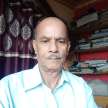Content warning
This story may contain sensitive material or discuss topics that some readers may find distressing. Reader discretion is advised. The views and opinions expressed in this story are those of the author and do not necessarily reflect the official policy or position of Vocal.
Global News:A Journalist's Story
Living with Mental Illness and Facing Stigma:

News 1
------
Each day, John Scully starts offevolved through altering his t-shirt due to the fact it is soaked with sweat from the nightmares. He's eighty two years historic and has extreme depression, incurable PTSD, and incurable anxiousness disorder. For the previous forty years, he is suffered from persistent ache that physicians cannot pinpoint and generally brush aside as psychological. John regularly wakes up thinking, "Not some other day." This is his story of fighting intellectual sickness and the stigma that comes with it.
John feels invisible, simply like many humans struggling with intellectual fitness issues. Society frequently turns a blind eye to their struggles, treating them as if they do not exist. The stigma is deep-rooted, and the embarrassment surrounding intellectual sickness leads to silence. John believes that if clinical help in loss of life had been handy at some stage in his darkest times, he would not be right here today. He would have died believing that his melancholy would in no way end. He speaks out for these who are afraid to have a voice and hopes to elevate focus about the want to tackle intellectual fitness troubles compassionately.
Medical help in loss of life (MAID) is reachable in Canada for adults with terminal or persistent bodily conditions, however now not for these with intellectual sickness alone. Canada is presently debating whether or not to lengthen MAID to humans with extreme intellectual illnesses. This controversial subject matter is being mentioned in different international locations like Germany, France, and the UK.
John's experience into journalism started in Wellington, New Zealand, the place he grew up. His extreme allergies saved him out of college for lengthy periods, main his mother and father to recommend he analyze a trade. He began washing flooring at a nearby newspaper, which in the end led him to a career in broadcast journalism. He labored for countless information outlets, consisting of CBC and the BBC, overlaying testimonies in more than a few international locations and warfare zones. The extreme experiences and chance he confronted left him with profound trauma and PTSD.
John recollects masking testimonies in hostilities zones like Northern Ireland and on the India-Pakistan border, the place he witnessed unattainable horrors. He describes how he would manage his fear to get the story, then return to the inn (if there was once one) and drink closely to cope. This unhealthy sample used to be his way of dealing with the trauma and stress. However, he admits that he is paid a big fee for it.
The ongoing debate about MAID for humans with intellectual sickness is complex, with more than a few perspectives. Advocacy organizations like Dying with Dignity have viewed an enlarge in calls from humans with intellectual fitness problems as the dialogue features momentum. These agencies are taking steps to make sure they can help and guard these who are looking for their help, emphasizing the significance of suicide prevention.
John's story is a reminder of the considerable challenges human beings with intellectual sickness face and the significance of recognizing their struggles. The debate over medically assisted demise for these with intellectual sickness ought to be approached with compassion and understanding, making sure that every person receives the aid they need.
---------------***********----------------
News 2
-------------
Famine Looms in Northern Gaza Amidst Ongoing Conflict
The United Nations has issued a grave warning concerning an impending famine in northern Gaza. According to their reports, 70% of the populace in this place faces excessive starvation and the hazard of catastrophic famine. In response, Israel's army introduced plans to scale up resource deliveries in the coming days, emphasizing that addressing this problem is a pinnacle priority.
This comes after seven months of battle in Gaza, all through which greater than 34,000 humans have misplaced their lives. The violence escalated after Hamas attacked Israel on October 7, killing about 1,200 human beings and taking 253 hostages. The ongoing battle has brought on substantial devastation and left limitless households in determined need.
Despite the resource guarantees from Israel, the UN's human rights director has raised issues that Israel can also be the usage of hunger as a weapon of war, an allegation Israel firmly denies. As the humanitarian disaster deepens, it is integral to recognize the harsh realities confronted through these on the ground.
Given the restrictions on worldwide reporting from Gaza, BBC News managed to acquire different photos captured through an American medical doctor who currently again from the northern region, the place the disaster is most acute. This report, through journalist Fergal Keene, affords a glimpse into the dire prerequisites continued with the aid of the human beings of Gaza.
### Inside Gaza: A Doctor's Journey Through Chaos
Dr. Samatar, who commonly works in a high-tech clinic in Chicago, traveled to Gaza to aid these affected by using the ongoing conflict. Upon crossing the border, he was once met with scenes of devastation and despair. The sheer density of the population, blended with a lack of simple infrastructure, created an oppressive environment."
The air you breathe, you sense like you are decaying, simply respiratory it, due to the fact there are simply so many people," Dr. Samatar described. The humanitarian disaster was once palpable, with infinite lives striking in the balance. The photos published heartbreaking scenes of moms grieving over their lifeless youngsters and scientific personnel struggling to grant care with confined resources.
Dr. Samatar encountered sufferers like Ramy, who had shrapnel in his talent however no get right of entry to to CT scans or different integral scientific equipment. Despite the chaos and risks, medical doctors and useful resource employees persisted to work tirelessly to shop lives. However, the lack of sources and the regular bombardment made their efforts more and more challenging.
### The Human Cost of Conflict
One of the most poignant testimonies in the document used to be about toddler Nahed, simply three months old, who suffered from malnutrition and illness. Tragically, the toddler died quickly after being photographed, underscoring the dire penalties of the ongoing war. Similarly, Kharam Khadada, a 22-year-old woman, additionally died due to sickness and malnutrition, leaving in the back of grieving household members.
The document additionally highlighted the plight of youngsters like Jenna Iyad, who had pre-existing clinical stipulations that made them extra inclined to malnutrition. Now, as the warfare continues, their prerequisites have worsened, leaving them even greater vulnerable. Unfortunately, due to restrictions on resource deliveries, many sufferers are unable to be evacuated to safer areas for desirable treatment.
As the disaster in Gaza deepens, the global neighborhood is advised to tackle the humanitarian wants of the populace and locate a peaceable decision to the conflict. The memories of these struggling in the vicinity serve as a stark reminder of the human price of hostilities and the pressing want for compassion and action.
---
About the Creator
Paresh Chandra Roy
Paresh Chandra Roy is a dedicated content writer with a passion for crafting compelling narratives and engaging copy. With a keen eye for detail and a deep understanding of various topics.






Comments
There are no comments for this story
Be the first to respond and start the conversation.